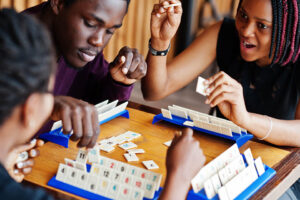Adolescence is a period of rapid change. Your little girl grows boobs overnight and every time you turn around, your son’s voice has dropped another octave. Plus, you’ve practically given up on keeping track of their friends.
Social changes are part of your middle or high schooler’s development and adolescent social development impacts your child’s behavior, relationships, and emotional well-being.
In this post, we’ll uncover the various stages of social development that adolescents experience and gain insights into their social interactions, friendships, and identity formation.
According to famed psychoanalyst Erik Erikson, humans go through eight stages of development. School-age and adolescents (ages 7-18) will move through the “Industry vs. Inferiority” and “Identity vs. Confusion” stages before reaching young adulthood. In the “Industry vs. Inferiority,” youth “develop self-confidence in abilities when competent or sense of inferiority when not. The “Identity vs. Confusion” stage is when your middle or high schooler “experiments with and develops their identity and role.” Some milestones you may notice in these periods include “increased interest in friends, “quarrels more often,” “moodiness” or “rejecting things from childhood.”
The Four Pain Points
Four areas will or are currently consuming your child’s life: independence, body image, peer relations, and identity.
As adolescents move toward independence, it usually “creates a lot distress for parents as they’ll begin to pull away and show less interest in family activities.” If you’ve yet to experience this with your middle schooler, be prepared for obsessive concerns about their appearance and how others view them. “Most early adolescents are not sure what to think of the changes in their body and accompanying hygienic responsibilities.”
We hate to say it, but your child’s friends may have their ears more than you do in these stages.
When it comes to identity, adolescents ask big questions like “Who am I? and “What am I supposed to do in the world”? Adolescents search for a sense of self and personal identity through an intense exploration of personal values, beliefs, and goals.
Behavior
It’s not quite Jekel and Hyde, but teens’ mood changes can be just as rapid. They’re cheerful one minute, then crying the next. They feel invincible, then feel invisible.
Part of the reason your middle schooler’s emotions are so “up and down” is because of biological and hormonal changes such as the start and completion of puberty and possible sexual experimentation.
Adolescents need help navigating these new and often intense behaviors. Their growth in these areas can occur at different rates, putting them at “higher risk for risk-taking behaviors and emerging mental health issues“. In fact, starting in early adolescence, compared with males, females have rates of anxiety that are about twice as high and rates of depression that are 1.5 to 3 times as high.
Relationships
Your tween may not think about dating and relationships like you are. As teens develop their identity, they’ll feel varying pressure to be “attractive” to others.
They could envision holding hands, eating lunch together and sitting beside each other on the bus. Sex may not be the issue…yet. Either way, as the parent, you set the tone for what dating looks like for your tween and if you’re comfortable with them “dating” in the first place.
A good rule of thumb for teaching your middle or high schooler about any relationship is to ensure they understand what a healthy one looks like. Talk to them about setting boundaries, good communication and positive self-esteem. Anyone who constantly violates these isn’t worth building a relationship with.
Regarding sexual relationships, we like what Planned Parenthood has to say. They emphasize that consent is THE priority in any sexual behavior.
- If anyone tries to make you do anything you don’t want to do, you can tell them, “I don’t want to do that. Let’s do something else instead.” If they don’t listen, try not to hang out with them anymore.
- In a relationship, it’s never okay for 1 person to pressure the other to do anything they don’t want to do.
- It’s never okay to touch someone in a sexual way without their consent. If someone does that to you, you can always tell me, your teacher, or your [aunt/uncle/grandparent/another adult you trust.]
- Rape and sexual assault are crimes, and they’re never the fault of the victim.
How to help your child navigate social changes in adolescence
The first step in helping your kid through adolescence is working on you. You’ve got to be at your best to offer your kids the best you can. If you’re in an unhealthy mental, physical, and spiritual state, your ability to parent effectively will be impacted. Barry Winbolt, psychologist, coach, and therapist, insists the bottom line of parenting isn’t about the kids— it’s about personal development.
After you’ve set yourself straight, the next step is to commit to communicating with your teen. Even if they protest, remember that communication is crucial in this period. Your high schooler is already prone to keep information private from you. Take the initiative to stay on top of what’s happening in their lives and where they may need more support but don’t know how to ask for it.
Adolescent social development doesn’t have to be as tumultuous as depicted in TV and film. Being present, patient, communicative, and understanding as your child grows into the person they’re becoming helps you get through inevitable rough patches.
For more resources for busy parents raising teens visit the Parent Zone!






